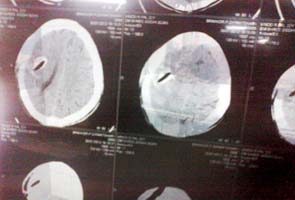
From left, Li Liu, Scott A.
Small and Karen Duff examining a mouse brain. Dr. Small and Dr. Duff
used mice to study Alzheimer's.
Alzheimer’s disease
seems to spread like an infection from brain cell to brain cell, two
new studies in mice have found. But instead of viruses or bacteria, what
is being spread is a distorted protein known as tau.
The surprising finding answers a longstanding question and has immediate
implications for developing treatments, researchers said. And they
suspect that other degenerative brain diseases like Parkinson’s may spread in a similar way.
Alzheimer’s researchers have long known that dying, tau-filled cells
first emerge in a small area of the brain where memories are made and
stored. The disease then slowly moves outward to larger areas that
involve remembering and reasoning.
But for more than a quarter-century, researchers have been unable to
decide between two explanations. One is that the spread may mean that
the disease is transmitted from neuron to neuron, perhaps along the
paths that nerve cells use to communicate with one another. Or it could
simply mean that some brain areas are more resilient than others and
resist the disease longer.
The new studies provide an answer. And they indicate it may be possible
to bring Alzheimer’s disease to an abrupt halt early on by preventing
cell-to-cell transmission, perhaps with an antibody that blocks tau.
The studies, done independently by researchers at Columbia and Harvard,
involved genetically engineered mice that could make abnormal human tau
proteins, predominantly in the entorhinal (pronounced en-toh-RYE-nal)
cortex, a sliver of tissue behind the ears, toward the middle of the
brain, where cells first start dying in Alzheimer’s disease. As
expected, tau showed up there. And, as also expected, entorhinal cortex
cells in the mice started dying, filled with tangled, spaghettilike
strands of tau.
Over the next two years, the cell death and destruction spread outward
to other cells along the same network. Since those other cells could not
make human tau, the only way they could get the protein was by
transmission from nerve cell to nerve cell.
And that, said Dr. Samuel E. Gandy, associate director of the Alzheimer’s Disease Research Center at Mount Sinai School of Medicine in New York, was “very unexpected, very intriguing.”
Although the studies were in mice, researchers say they expect that the
same phenomenon occurs in humans because the mice had a human tau gene
and the progressive wave of cell death matched what they see in people
with Alzheimer’s disease.
One study, by Karen Duff and Dr. Scott A. Small and their colleagues at the Taub Institute for Research on Alzheimer’s Disease and the Aging Brain at Columbia University Medical Center, was published on Wednesday in the journal PLoS One. The other, by Dr. Bradley T. Hyman, director of the Alzheimer’s Disease Research Center at Massachusetts General Hospital, and his colleagues, is to be published in the journal Neuron.
Both groups of researchers were inspired by the many observations over
the years that Alzheimer’s starts in the entorhinal cortex and spreads.
But, said Dr. Small, “what do we mean by ‘spreads?’ ”
Researchers knew that something set off Alzheimer’s disease. The most
likely candidate is a protein known as beta amyloid, which accumulates
in the brain of Alzheimer’s patients, forming hard, barnaclelike
plaques. But beta amyloid is very different from tau. It is secreted and
clumps outside cells. Although researchers have looked, they have never
seen evidence that amyloid spreads from cell to cell in a network.
Still, amyloid creates what amounts to a bad neighborhood in memory
regions of the brain. Then tau comes in — some researchers call it “the
executioner” — piling up inside cells and killing them. If some cells
take longer than others to succumb to the bad neighborhood, that would
explain the spread of the disease in the brain, and there would be no
need to blame something odd, like the spread of tau from cell to cell.
Studies in humans, though, could not determine whether that hypothesis
was correct. They involved autopsy and brain imaging studies and were
“indirect and inconclusive,” Dr. Small said.
Looking at the brains of people who have died of the disease, Dr. Duff
said, is like looking at a wrecked car and trying to figure out the
accident’s cause. Faulty brakes? Broken struts?
The question of which hypothesis was correct — tau spreading cell to
cell, or a bad neighborhood in the brain and cells with different
vulnerabilities to it — remained unanswerable. Dr. Hyman said he tried
for 25 years to find a good way to address it. One of his ideas was to
find a patient or two who had had a stroke or other injury that severed
the entorhinal cortex from the rest of the brain. If the patient
developed Alzheimer’s in the entorhinal cortex — and it remained
contained there — he would have evidence that the disease spread like an
infection. But he never found such patients.
The solution came when researchers were able to develop genetically
engineered mice that expressed abnormal human tau, but only in their
entorhinal cortexes. Those mice offered the cleanest way to get an
answer, said John Hardy, an Alzheimer’s researcher at University College London who was not involved in either of the new studies.
There is another advantage, too, Dr. Hyman said. The mice give him a
tool to test ways to block tau’s spread — and that, he added, “is one of
the things we’re excited about.”
But if tau spreads from neuron to neuron, Dr. Hardy said, it may be
necessary to block both beta amyloid production, which seems to get the
disease going, and the spread of tau, which continues it, to bring
Alzheimer’s to a halt.
He and others are also asking if other degenerative diseases spread
through the brain because proteins pass from nerve cell to nerve cell.
Dr. Hardy thought he saw provocative human evidence that it might be
happening in Parkinson’s disease. Two Parkinson’s patients being treated
by a colleague had fetal brain cells implanted to replace dead and
dying neurons. When the patients died, years later, autopsies showed
they still had the fetal cells, but they had balls of a Parkinson’s
disease protein, synuclein, inside. The most obvious way that could
happen, the researchers reasoned, was if the toxic protein had spread
from the patient’s diseased cells to the healthy fetal cells. But they
could not rule out the bad-neighborhood hypothesis.
Now, Dr. Hardy said, with the mouse studies, the issue of a bad
neighborhood is settled. The answer in Alzheimer’s disease, he said, “is
that isn’t possible.”
“That is what is different between these papers and all the others,” Dr.
Hardy said. “It isn’t a bad neighborhood. It is contagion from one
neuron to another.”














